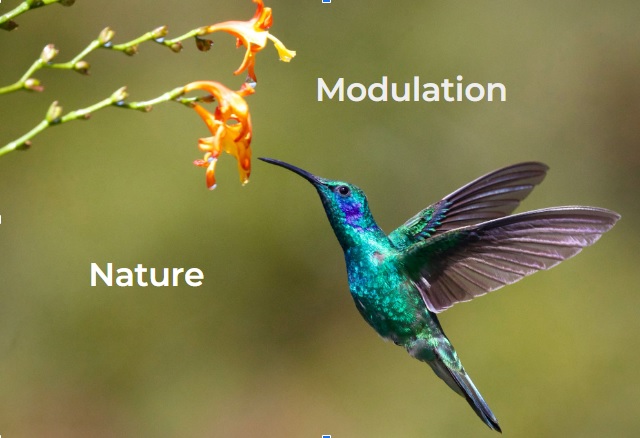
What kind of modulation happens in nature? In hummingbirds, it’s created by movement and friction — and sensed by mites evolved to detect it.
Image adapted from a photo by James Wainscoat on Unsplash.
García-Robledo et al. (2025) showed that hummingbird flower mites detect and respond to modulated electric fields generated by hummingbirds, using electroreception to facilitate rapid host detection and airborne transfer.
Nature’s Version of Modulation
In the case of the hummingbird, the modulation appears to be periodic and mechanical, driven by:
- Wingbeats (which generate cyclic fluctuations in charge and air pressure)
- Rapid movement through air (causing triboelectric charging/discharging)
- Intermittent contact with flower surfaces and air particles
It’s not digital modulation (like QAM or OFDM used in wireless tech), but it’s still structured, time-varying electric field activity.
Key Differences Between Hummingbird-Generated and Wireless Modulation
While man-made electromagnetic signals are deliberately modulated to carry data, hummingbird-generated electric fields are modulated naturally by movement, wingbeats, and contact with air and surfaces. These natural fields are analog, low-frequency, and often non-polarized — yet organisms like flower mites have evolved to detect them, showing that modulation is a biologically meaningful phenomenon in both nature and technology.
Natural vs. Man-Made Modulation
Here’s how natural modulation from hummingbirds compares to the modulation used in wireless technologies

Why It Matters
This research highlights that modulation is not an artificial concept — it also exists in the natural world. Organisms have evolved to respond to modulated electric fields for survival, long before humans began using them for communication.
It also raises a broader point:
If natural modulation can shape biological behavior, what about the effects of artificial modulation? Could structured, high-frequency signals from modern devices interact with biological systems in unintended ways?
What Kind of Modulation Happens in Nature? It turns out, nature’s version is analog, irregular, and biologically relevant. From flower mites to pollinators, living organisms are tuned not just to electric fields — but to how those fields change over time.
This article includes content and visual support generated with the help of ChatGPT, an AI developed by OpenAI.
Reference
García-Robledo, C., Dierick, D., & Manser, K. (2025). Electric transportation and electroreception in hummingbird flower mites. Proceedings of the National Academy of Sciences, 122(5), e2419214122. https://doi.org/10.1073/pnas.2419214122
Further Reading
Wireless Communication Evolution: Modulation Techniques and Health Concerns with Pulse Modulation
